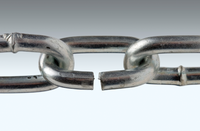
Lead Image © Irina Tischenko, 123RF.com
Keeping Docker containers safe
Weak Link
Few debate that the destiny of a hosting infrastructure is running applications across multiple containers. Containers are a genuinely fantastic, highly performant technology ideal for deploying software updates to applications. Whether you're working in an enterprise with a number of critical microservices, tightly coupled with a pipeline that continuously deploys your latest software, or you're running a single LEMP (Linux, Nginx, MySQL, PHP) website that sometimes needs to scale up for busy periods, containers can provide with relative ease the software dependencies you need across all stages of your development life cycle.
Containers are far from being a new addition to server hosting. I was using Linux containers (OpenVZ) in production in 2009 and automatically backing up container images of around 250MB to Amazon's S3 storage very effectively. A number of successful container technologies have been used extensively in the past, including LXC, Solaris Zones, and FreeBSD jails, to name but a few.
Suffice to say, however, that the brand currently synonymous with container technology is the venerable Docker. Vendors, embracing their ever-evolving technology, in hand with clever, targeted marketing and some very nifty networking improvements, have driven Docker to the forefront of techies' minds and helped Docker ride on the crest of the DevOps wave. Docker provides businesses at all levels the ability to approach their infrastructure from a different perspective and, along with other DevOps technology offerings, has genuinely twisted the old paradigm and rapidly become the new norm.
As more businesses adopt such technologies, however, teething problems are inevitable. In the case of Docker, the more you use it, the more concerned you become about secure deployment. Although Docker's underlying security is problematic (great strides have been made to improve it over time), users tend to treat containers as though they are virtual machines
...Buy this article as PDF
(incl. VAT)
Buy ADMIN Magazine
Subscribe to our ADMIN Newsletters
Subscribe to our Linux Newsletters
Find Linux and Open Source Jobs
Most Popular
Support Our Work
ADMIN content is made possible with support from readers like you. Please consider contributing when you've found an article to be beneficial.







